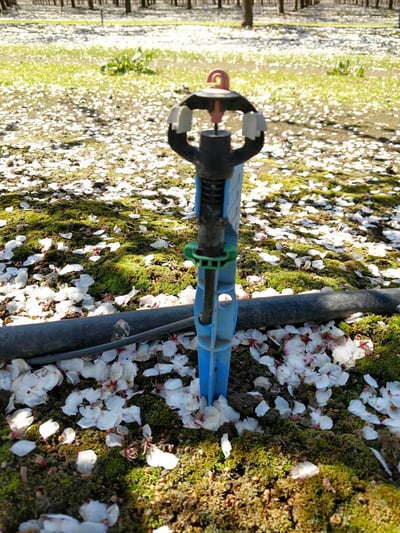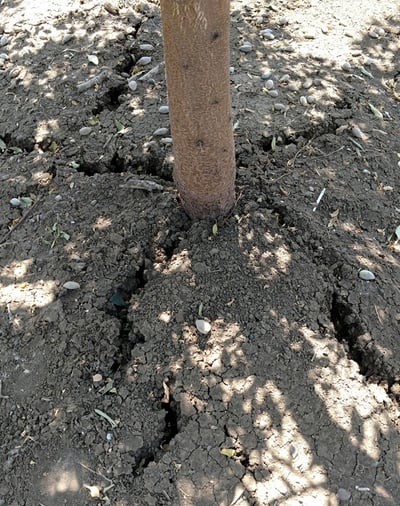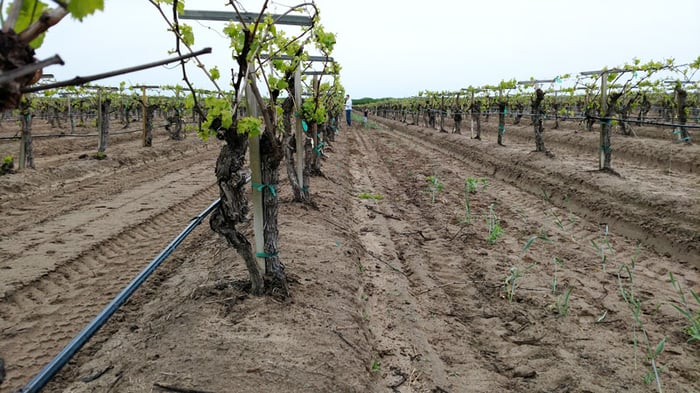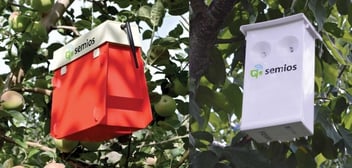In the world of plant fertility, you will be hard pressed to find an article that doesn't reference the “4R’s of Nutrient Management”. Though it may seem repetitive, these concepts are heavily reinforced for good reason.
The most important aspects of fertility management can be summarized in the 4R’s. The 4R’s of nutrient management include:
- Right Source
- Right Rate
- Right Timing
- Right Place
Even though nutrient management is a different science, irrigation managers can also take away some important learnings from the 4R’s. Read on to learn about the 4R's of Irrigation Management.

Micro sprinkler in early spring
1. Right Source
In nutrient management, choosing the right source is critical. Most nutrients can be applied in many forms and mixtures, but soil type, pH, crop, temperature, and other factors all play a role in determining which source will be the most effective.
In irrigation, there are fewer options. The concern is water. And while most growers do not have a lot of say in what their water is, knowing the source and quality of your water can help you make better decisions on how and when to apply it.

A reservoir filling up to begin the season
Water comes in many different states. Take this memorable example of water that was dredged up with petroleum from deep wells in the Oildale, California area. The oil was separated off, but the water still had a distinct tar smell. The water came from the well with some extra salts, especially boron, and was somewhere around 140oF. Delivered unblended to the farm, which made it especially effective at combating frost. However, for normal use, it needed to be blended with better water in order to prevent the accumulation of salts. Ultimately, it is an effective way to increase the total amount of water available, however appropriate care is needed to consistently leach salts down and out of the root zone.
Surface water, or water that comes as runoff from snowmelt, is usually the gold standard for irrigation. It tends to be very pure and clean. However, through long transport from the mountains and through canals and reservoirs, organic matter, such as algae and bacteria, can grow. While the algae and bacteria are harmless in and of themselves, they plug up emitters, filters, and headgate grates.
Filters and filter backflushes are critical to a properly functioning irrigation system, but filters that plug frequently can cause excessive flush cycles and water loss. A single backflush event can expel up to 750 gallons of water per sand media tank in the system. For a typical six-tank system, that can add up to 4,500 gallons. If that system is forced to flush every hour for a 24-hour irrigation set, that amounts to 108,000 gallons of water or 4.5 ac-in of water! That is water that is typically lost or goes back into the canal. Keep in mind that most district flow meters count that water lost to flushing as water used. You will both be charged for it and have it count against your total usage for that season.

Dirty water from the filter backflush
Generally, very pure water is a good thing, but soils with low calcium and magnesium and pure water don’t mix, literally. The pure water and soil with low cations do not react well together chemically, and the soil deflocculates, causing the soil to seal up and impede the infiltration of water. This often leads to large amounts of water ponding up and running off the edge of the field. In this case, gypsum can be used to “dirty” the water and open the soil up so water can be more easily absorbed into it.
2. Right Rate
Any excessive amount of fertilizer applied to a crop is a waste of money and a potential hazard to the environment. So, putting the right amount on is a critical part of managing nutrition. The right rate is possibly even more critical in irrigation.
There are three components to the right rate in irrigation.
The first is how much water your irrigation system puts out, the second is how long you put it on (duration), and the third is how frequently.
Irrigation designers usually consider the maximum ET for a crop when determining flow rates on a new irrigation system. It is less common, but still important for them to consider the soil’s ability to take that water in. Most of the time, things work out just fine, but there are situations when the emitter flow rate doesn’t match the soil’s characteristics and water waste follows.
Here are two examples:
- In one, higher flow drippers were put on very sandy soil. There is a common misconception that sandy soils can’t move water laterally. This isn’t true. In order to get the water to move laterally, the water needs to be put on slowly, so that the sand has time to move sideways before gravity pulls it down. In sandy soil with high flow, gravity pulls the water straight down in a narrow cylinder. Extra water is used to keep that small area full.
- The other situation occurs when putting high flow rates on clay soils. The heavier the soil, the less quickly water infiltrates. Instead of going in and straight down, like in sand, the water accumulates on top of the soil until it starts to run off the end of the field.

Adding too much water too quickly can cause ponding
Irrigation duration is how long water is being applied. This can be a hard factor to manage if you don’t have a remote system to control it. Most duration options are limited by how many people are out operating the systems.
As you can imagine, water that is run off for too long results in leaching water out of the bottom of the root zone, or running a lot of water off the edge of the field.
However, on the other end of the spectrum, irrigation sets that are too short and too frequent tend to overfill the soil early in the season but let the soil deplete later in the season.
Frequency is often overlooked. Sometimes we water just once a week because that is when we have water, or that is how long it takes to get through all of the fields. But frequency helps to modulate how water moves in the soil and how wet or dry it can get.
Let's go back to the situation mentioned above, with high-flow drippers put on sandy soil. Outside of replacing the drippers, it is possible to break the irrigation set into shorter, more frequent sets. With this, “breaks” are given so that the soil can work on moving the water laterally within. But, irrigating frequently with no consideration of how much water is already in the soil leads to water waste and soil-borne diseases. On the other hand, very dry soil can be hard to rehydrate and may result in excessive runoff as water is working its way down into the soil.

Cracking soils need shorter, more frequent irrigations.
3. Right Timing
In general, a tree without soil-associated stress is a happy tree.
The right timing with fertilizer gets it there when it is needed, but not too early when it could be lost.
In irrigation, little to no stress is usually the best option. But we can do better than that.
Every crop has periods where a little bit of drought stress can do some good. From managing disease and limiting the period of susceptibility to pests in nut crops to coloration and development of flavor profiles in grapes, vegetation control in cherries, and fruit sizing in apples, the right amount of stress at the right time does a lot of good. A lot of the best practices regarding how to do that effectively are still being developed, but experimenting with stress during the right periods will pay off.

Even in sandy soils, timing plays an important role
The most missed timing for irrigation occurs at the beginning and end of the season. You can’t be involved in crops and not be at least a little excited when bloom breaks and buds push. Some may see this new fragile growth and figure it needs extra care. However, the reality is actually very different, at least when it comes to water and nutrition.
This early growth is driven by resources stored away in the fall. In the eagerness to provide for the new growth with water and fertilizer, there is a risk of overdoing it and making the soil too wet or putting fertilizer on before the trees and vines can even uptake them.
Moist soil, not wet soil, is the rule in the spring. Importantly, don't make this judgment on the top 6” of the soil. Look a little deeper in the early season to make the determination.
Resources from the fall are gathered from irrigation and fertilizer applied in the fall. Generally, temperatures are lower and the trees' needs are lower than they were in the summer, so a little goes a long way. But while we over-irrigate in the spring, we tend to under-irrigate in the fall. The plants don't need a ton, just enough to keep them making and storing sugar and nutrients for the spring.
4. Right Place
If the roots can’t reach it, they likely can’t get it. But let’s not get carried away.
Repeated studies have shown that roots adjust to match the wetting zone. Drip irrigation is the obvious choice in most cases, and trees and vines are very effective at structuring their roots around the areas that deliver water. So, don’t worry about delivering water to other areas, just keep it going where your main delivery system provides the water. This reduces the amount of the soil surface that is wetted, thus reducing evaporation from the soil as well.

Roots adjust to grow where water is applied, so applying fertilizer where water goes is ideal
The same goes when looking down into the soil as well. Most crops, even large trees, have most of their roots above 24” in the soil. Spending a lot of time and water pushing water beyond three feet deep tends to waste the water that a tree can’t effectively use and causes conditions that are ideal for root diseases. Just keep an eye on where your roots are and you will do well.
The 4R’s seem to have just as much meaning in irrigation as they do in nutrient management. The key is using these concepts to help you use water effectively.
When water is limited, the cost of waste is more than just the money you use to purchase water. Every drop that doesn’t serve a purpose needs to be controlled and limited. With more time, practice, and innovation, growers will become even more proficient at producing more with less waste.
While a lot of considerations were mentioned here, even one or two of them can make a big difference in how effectively you use the resources you have. Feel free to reach out with any questions specific to your orchard or vineyard. We're always happy to help.
To learn more about how Semios Water Management tools can help you with soil moisture monitoring, evapotranspiration tracking, irrigation activity monitoring and planning, irrigation automation and control, fill out the form below, and we will send more information your way.
Get More Information
Learn More
Making Informed Irrigation Decisions With Semios



